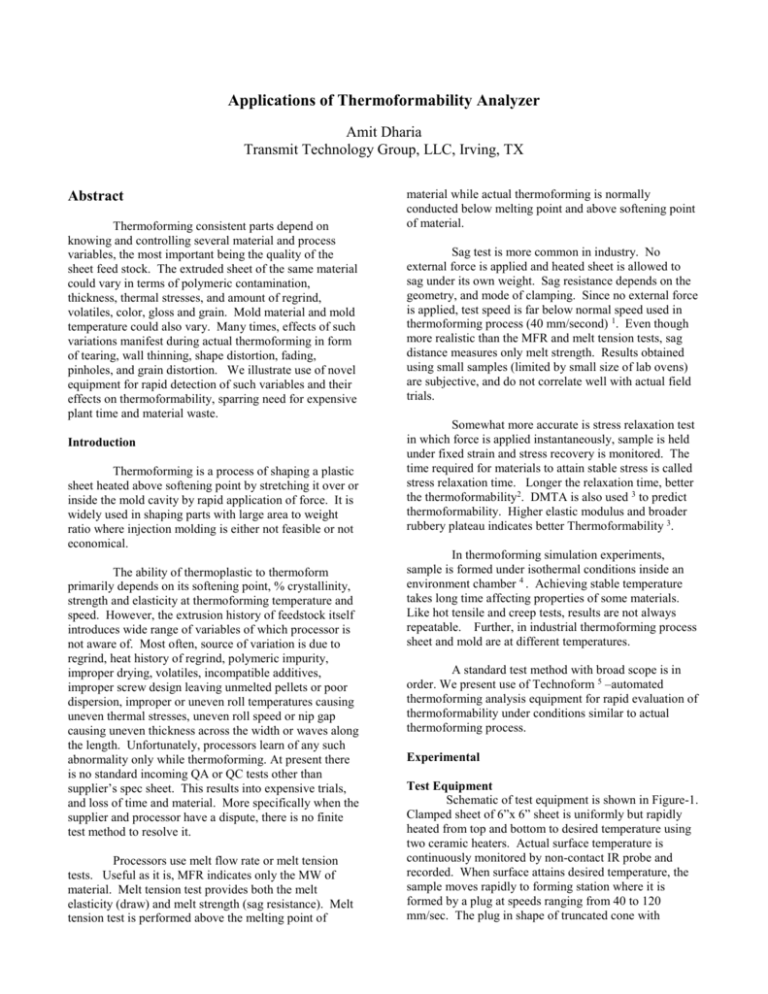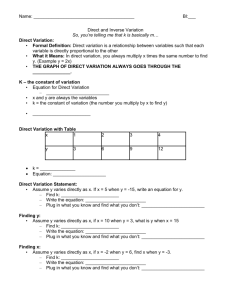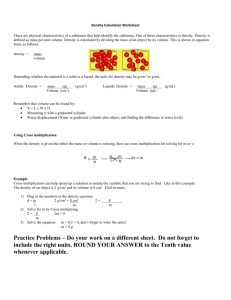Applications of Thermoformability Analyzer
advertisement

Applications of Thermoformability Analyzer Amit Dharia Transmit Technology Group, LLC, Irving, TX Abstract Thermoforming consistent parts depend on knowing and controlling several material and process variables, the most important being the quality of the sheet feed stock. The extruded sheet of the same material could vary in terms of polymeric contamination, thickness, thermal stresses, and amount of regrind, volatiles, color, gloss and grain. Mold material and mold temperature could also vary. Many times, effects of such variations manifest during actual thermoforming in form of tearing, wall thinning, shape distortion, fading, pinholes, and grain distortion. We illustrate use of novel equipment for rapid detection of such variables and their effects on thermoformability, sparring need for expensive plant time and material waste. Introduction Thermoforming is a process of shaping a plastic sheet heated above softening point by stretching it over or inside the mold cavity by rapid application of force. It is widely used in shaping parts with large area to weight ratio where injection molding is either not feasible or not economical. The ability of thermoplastic to thermoform primarily depends on its softening point, % crystallinity, strength and elasticity at thermoforming temperature and speed. However, the extrusion history of feedstock itself introduces wide range of variables of which processor is not aware of. Most often, source of variation is due to regrind, heat history of regrind, polymeric impurity, improper drying, volatiles, incompatible additives, improper screw design leaving unmelted pellets or poor dispersion, improper or uneven roll temperatures causing uneven thermal stresses, uneven roll speed or nip gap causing uneven thickness across the width or waves along the length. Unfortunately, processors learn of any such abnormality only while thermoforming. At present there is no standard incoming QA or QC tests other than supplier’s spec sheet. This results into expensive trials, and loss of time and material. More specifically when the supplier and processor have a dispute, there is no finite test method to resolve it. Processors use melt flow rate or melt tension tests. Useful as it is, MFR indicates only the MW of material. Melt tension test provides both the melt elasticity (draw) and melt strength (sag resistance). Melt tension test is performed above the melting point of material while actual thermoforming is normally conducted below melting point and above softening point of material. Sag test is more common in industry. No external force is applied and heated sheet is allowed to sag under its own weight. Sag resistance depends on the geometry, and mode of clamping. Since no external force is applied, test speed is far below normal speed used in thermoforming process (40 mm/second) 1. Even though more realistic than the MFR and melt tension tests, sag distance measures only melt strength. Results obtained using small samples (limited by small size of lab ovens) are subjective, and do not correlate well with actual field trials. Somewhat more accurate is stress relaxation test in which force is applied instantaneously, sample is held under fixed strain and stress recovery is monitored. The time required for materials to attain stable stress is called stress relaxation time. Longer the relaxation time, better the thermoformability2. DMTA is also used 3 to predict thermoformability. Higher elastic modulus and broader rubbery plateau indicates better Thermoformability 3. In thermoforming simulation experiments, sample is formed under isothermal conditions inside an environment chamber 4 . Achieving stable temperature takes long time affecting properties of some materials. Like hot tensile and creep tests, results are not always repeatable. Further, in industrial thermoforming process sheet and mold are at different temperatures. A standard test method with broad scope is in order. We present use of Technoform 5 –automated thermoforming analysis equipment for rapid evaluation of thermoformability under conditions similar to actual thermoforming process. Experimental Test Equipment Schematic of test equipment is shown in Figure-1. Clamped sheet of 6”x 6” sheet is uniformly but rapidly heated from top and bottom to desired temperature using two ceramic heaters. Actual surface temperature is continuously monitored by non-contact IR probe and recorded. When surface attains desired temperature, the sample moves rapidly to forming station where it is formed by a plug at speeds ranging from 40 to 120 mm/sec. The plug in shape of truncated cone with rounded of 1” bottom, 2.5” top diameter and 4” height is made of Epoxy. The force to form is measured using a precision load cell (0.5%) and recorded as function of draw depth and time. After forming, plug remains inside the part for specified time. Formed part is cooled, removed, and analyzed for thickness distribution. Materials: Extruded sheets of various materials were obtained from various sources as shown in Table-1. Results and discussion: In general, force vs. depth plots show four distinct regions. (1) Negligible force - material is hot with very small portion in contact with plug, (2) Linear increase in force –hot but elastic material, (3) stretching without force -material is in rubbery state, and (4) rapid increase in force - material is cooling below forming temperature and walls are thinning unevenly. The width of each zone will vary with test temperature, plug shape, and speed. Under similar test conditions, force vs. depth plots for given material should be the same within the experimental error. Isothermal vs. Non isothermal Test Methods In isothermal tests, plug and material are at the same temperature. To demonstrate the differences in isothermal vs. non-isothermal testing, 35-mil thick black sheet of HIPS was formed at 130 C and 8 mm/second speed. In isothermal case, sample and plug were heated for 20 minutes in environmental chamber. As shown in Figure-2, in non-isothermal test, material in contact with the plug begins to cool and force required gradually increases. Under isothermal condition, both plug and material are at the same temperature and material continues to yield. Plug (mold) temperature has significant effect on thermoforming characteristics. Effect of Plug Temperature Repeated forming without cooling will gradually raise plug surface temperature. To illustrate the effect of plug temperature, 35 mil HIPS was formed consecutively with and without forced cooling plug. As can be seen from Figure-3, when plug temperature is controlled, subsequent parts form very consistently but parts vary significantly when plug temperature is not controlled. Effect of Plug Surface Smoothness of plug and thermal conductivity of plug material can affect forming characteristics. The same HIPS grade used in above experiments was formed using three different plugs of same shape but made of different epoxy foam materials. Figure-4 illustrates the effect of plug smoothness and thermal conductivity. B1X has lower thermal conductivity than WF and WFT, and apparently produced better part. Effect of sample thickness Heating is critical and controlling step in thermoforming. Fast heating is preferred for production efficiency. Thin sheets heat faster and more uniformly with increase in energy input. Thick sheets take longer time to heat and heat unevenly from core to surface. This results in built-in thermal stresses and poor shape retention upon cooling. Rapid heating of thick sheet will result in even greater temperature gradient, surface scorching and discoloring. Figure-5 shows the heating rate and forming characteristics for 100 mil, 150 mil and 250 mil thick ABS/PC. As expected, 250-mil thick sheet took almost three times more time to heat. Thermoforming behavior was somewhat similar at low draw down ratio but at higher depths 250-mil thick sample required almost twice the force than 95 mil thick sample. Thick parts also showed significant post-process shape distortion. Effect of Color Additives Processors often ignore effect of color. Different colors absorb IR energy at different frequencies and hence heat differently. Some color concentrates act as nucleating agents in polyolefins. Metallic or mica based fillers acts as heat sink and when well dispersed can enhance the melt strength. To illustrate this effect, blue, red and green pearlascent color 35 mil thick COPP sheets were formed at 170 C and 40 mm/sec speed. Figure-4 (a) shows the heating rate for three samples and Figure-4 (b) their thermoforming behavior. The sample with metallic additive heats much faster than red and blue. Blue sheet, took longer time to attain forming temperature than red and showed less wall thinning than red. Effect of lot-to lot variations Unintended changes in incoming raw material or process conditions can result in part-to-part wall thickness variations. As mentioned earlier, inconsistency of incoming sheet feed stock is the serious concern. Cutsheets at the bottom of stack or at roll stock at the bottom of roll have different heat history and will form differently. Heavy gauge TPO (E3000, 190 mil)) sheets extruded on three different days from three different lots of materials were formed under identical test conditions. Figure-5 illustrates the subtle differences in forming behavior of three at higher draw ratios. TPO lot-1 showed lot more thickness variation while Lots 2 and 3 had identical thickness distribution. Effect of regrind Recycling of trims is necessary for efficient use of material, especially in heavy gauge parts. All plastics or additives are affected by heat and shear applied during sheet extrusion and forming, some more than the others. In filled materials, if product properties are dependent on the dispersion of additive, this secondary mixing can enhance properties. On the other hand some additives are heat sensitive e.g. Flame-retardants. Using too much regrind can affect not only the properties and surface appearance, but also formability. Figure-8 shows effect of regrind on 190 mil thick FRABS and 125 mil thick PP, 125 mil thick HIPS. Figure-1 Technoform – Thermoformability Analyzer In case of FR-ABS (Figure 7(a)), sample containing 100% regrind was black while one with 50% regrind was white. Even though there may be effect on their FR properties, material with higher % regrind thermoformed better, indicating that the second mixing enhanced dispersion of FR additive. GPPS and PP showed (Figure 8-b and 8-c) substantial loss in thermoformability upon reprocessing. In case of PP, adding regrind also resulted in faster cooling. Competitive analysis Under specified test conditions, force required to draw material to specific draw depth will vary with any process or material variables. This force can be used as quantitative tool for evaluating thermoformability. Table-1 summarizes change in force and draws depth at yield and force at 45 mm draw depth. Figure-2 Isothermal vs. Non-isothermal test 35 mil, HIPS, 130 C, 8 mm/second 130 C-20I Force (lb) Processor often wants to know thermoformability of two materials from different suppliers. Comparison of only physical properties can be quite deceiving as shown in Figure-9. Two commercial TPOs tailored for automotive application showed very different thermoforming characteristics. TPO 3500 had 20 C wider processing window than E3000 gray TPO. 12 10 8 6 4 2 0 1 (1) (2) (3) (4) (5) James. L. Throne, Technology of Thermforoming, Hnaser/Gradner Publications, pp266 (1990) D. Hylton and C. Chem, SPE ANTEC (1988) Thomas C. Yu, SPE ANTEC (1999) Bernhard Hegemann, David Liebing, Peter Eyerer, SPE ANTEC pp 909 (2004) A. Dharia and D. Hylton, SPE ANTEC, pp-1214 (2005) Acknowledgement: Author thanks Spartech Plastics for providing various cut sheet samples, and CMT Materials, Inc for providing various Epoxy foams. 3 4 5 Figure-3 Effect of Plug Temperature HIPS, 35 mil, 130 C, 40 mm/second Series1 Series2 Series3 12 10 Force (lbf) References: 2 Draw Depth (Inches) Conclusion Thermoforming test method presented here is simple, rapid, repeatable, and reflects actual thermoforming process more closely than previously used test methods. Use of new thermoforming analyzer for quality control and quality assurance in wide range of possible scenarios is demonstrated. Force required to form material specific draw depth can be used as a quantitative tool. 130 C-20NI 8 6 4 2 0 0 20 40 60 80 Depth (mm) 3(a) without plug cooling 100 120 #2 #3 95 #4 12 10 10 8 Froce (lbf) Force, Lbf #1 8 6 4 150 250 6 4 2 2 0 0 0 50 100 0 50 Depth, mm 100 Depth (mm) 3 (b) with plug cooling –Plug at ambient 5(b) – Effect of thickness on Formability Figure-4 Effect of Plug material Figure-6 Effect of color additives WF WFT Bix Red Blue Metalic Surface Temperature (C) 6 Force (lb) 5 4 3 2 1 132 82 32 0 0 0 50 100 20 40 150 60 80 100 time (sec) Depth (mm) 6(a) Effect of color additive on heating rates Figure-5 Effect of Sheet Thickness 250 200 150 red Metallic 0.8 250 mil Force (lb) 150 mil 12 10 8 6 4 2 0 150 0.6 0.4 0.2 0 100 0 50 50 100 Depth (mm) 0 0 500 1000 5(b) Effect of color additive on formability time (sec) Figure-7 Effect of Lot to lot variations 5(a) Effect of thickness on heating rate 1-1 1-2 1-3 10 8 Froce (lbf) Surface Temperature(C) 100 mil blue 6 4 2 0 0 20 40 Depth (mm) 60 Figure-8 Effect of % Regrind 50% RG PP Virgin 14 12 10 8 6 4 2 0 Froce (lbf) 15 10 5 0 0 50 100 0 Depth (mm) 40 60 80 100 Figure-8 Comparison of TPOs PS Regrind 170 15 180 190 170TPO 25 10 Force (lbf) Forming Force (lbf) 20 7 (c ) Polypropylene at 160 C, 40 mm/second, 125 mil 7(a) FRABS @ 170 C, 40 mm/sec, 190 mil thick PS Virgin PP Regrind 100% RG 5 0 0 20 40 60 80 100 20 15 10 5 Draw Depth (mm) 0 0 20 7(b) GPPS, 190 C, 40 mm/sec 40 60 80 100 Depth (mm) Table-1 Materials and Test Conditions Material Grade Thickness T© Speed mm/s Max. Force (lb) FRABS-50% RG FRABS-100% RG COPP -Blue COPP- Metallic TPO TPO TPO TPO ABS/PC ABS/PC ABS/PC GPPS-0 % RG GPPS--100% RG PP 0 RG PP-100 RG HIPS – WFT Plug HIPS – B1X Plug 572 572 80495 80495 UV Alloy 3500 UV Alloy 3500 UV Alloy 3500 E3000 Bayer 3030 Bayer 3030 Bayer 3030 Commercial Commercial Commercial Commercial Commercial Commercial 190 190 170 170 190 190 190 190 93 150 250 125 125 125 125 35 35 190 190 35 35 170 180 190 170 200 200 200 170 170 160 160 170 170 40 40 40 40 40 40 40 40 40 40 40 40 40 40 40 40 40 5 8 0.4 11.38 21 7 6.22 6.45 3 4 3.4 13.11 4.0 2.56 4.6 3.74 4.6 Draw Depth @Yield mm 55 58 50 109 52 50 52 50 59 52 59 120 120 68 71 72 85 Force Lb @ 45 mm Draw 4.50 6.00 0.30 1.0 19 7.25 5.19 6.68 3.4 4.3 6.0 3 1.15 0.774 0.444







